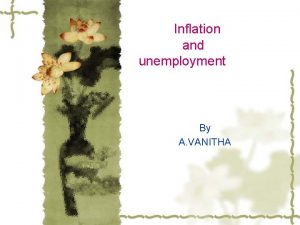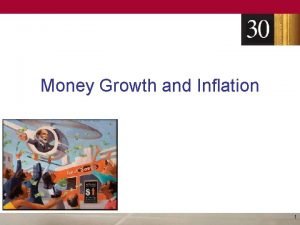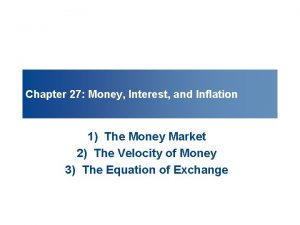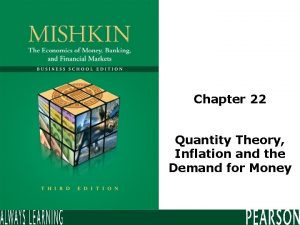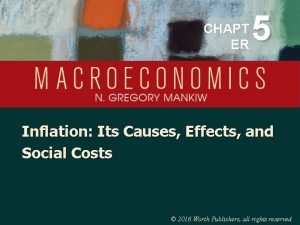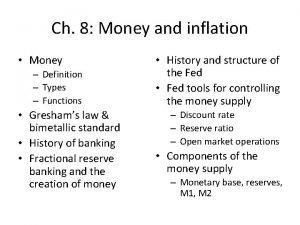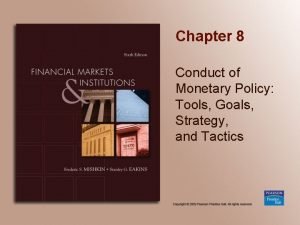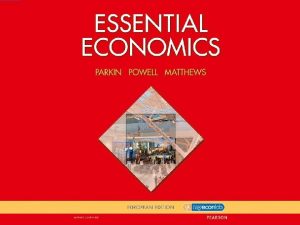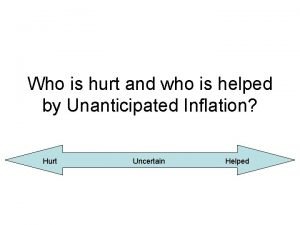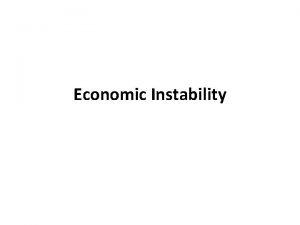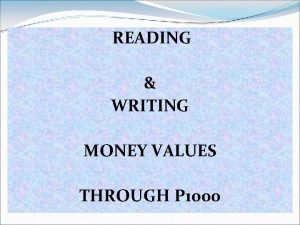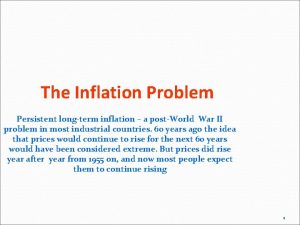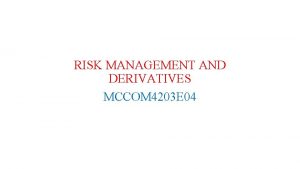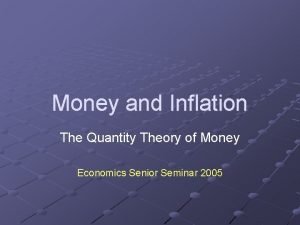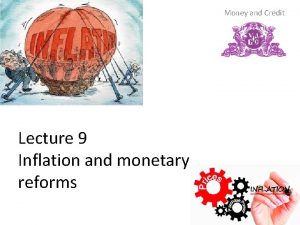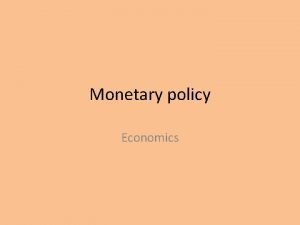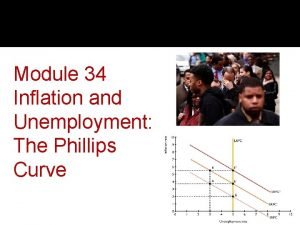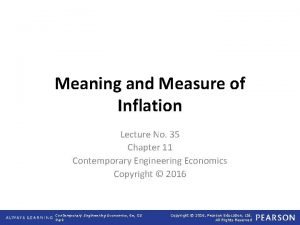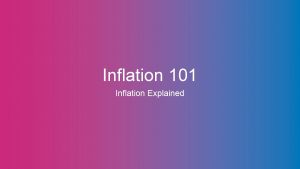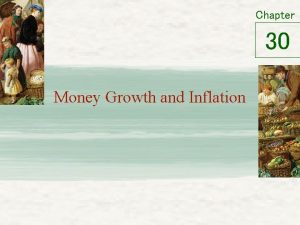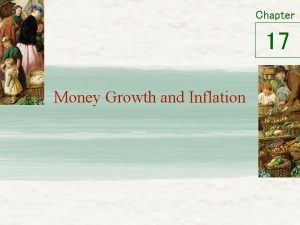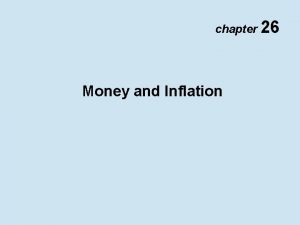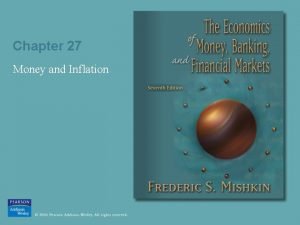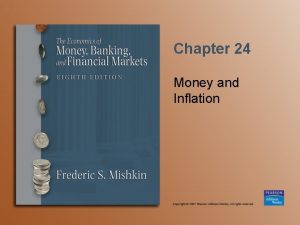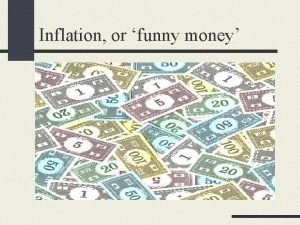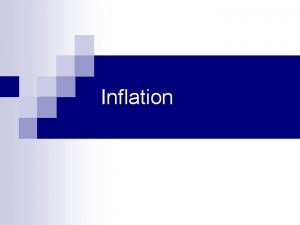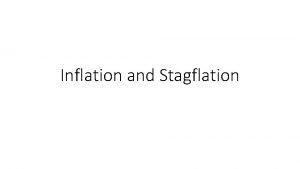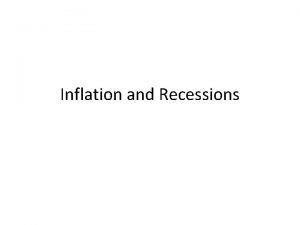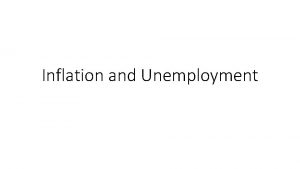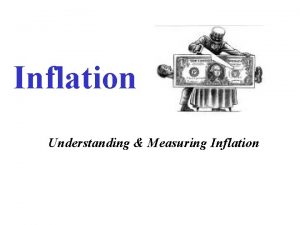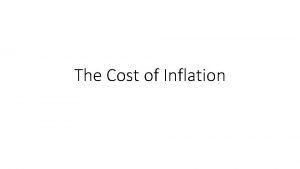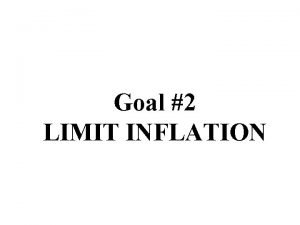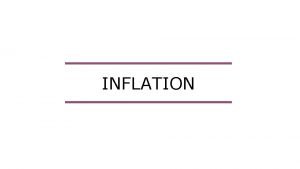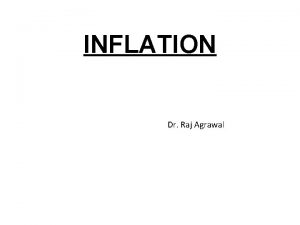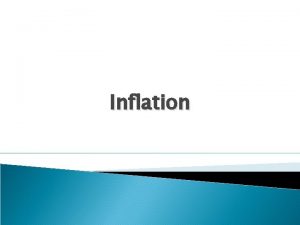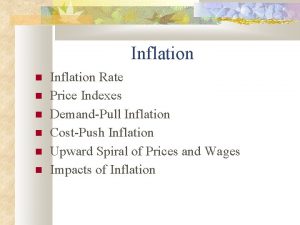Money and Inflation U S inflation and its








































- Slides: 40

Money and Inflation

U. S. inflation and its trend, 19602006 15% % change in CPI from 12 months earlier 12% long-run trend 9% 6% 3% 0% 1960 1965 1970 1975 1980 1985 1990 1995 2000 2005

Money: Functions • medium of exchange • store of value • unit of account

Money: Types 1. fiat money – has no intrinsic value – example: paper currency 2. commodity money – has intrinsic value – examples: gold coins, cigarettes in P. O. W. camps

The central bank • In the U. S. , the central bank is called the Federal Reserve (“the Fed”). • Open Market Operations are the primary monetary policy tool The Federal Reserve Building Washington, DC

Money supply measures, July 2009 symbo assets included l C Currency amount ($ billions) $853 M 1 C + demand deposits, travelers’ checks, other checkable deposits $1655 M 2 M 1 + small time deposits, savings deposits, money market mutual funds, money market deposit accounts $8349

The Quantity Theory of Money • A simple theory linking the inflation rate to the growth rate of the money supply. David Hume Milton Friedman

The quantity equation • assumes V is constant & exogenous • With V constant, the money supply determines nominal GDP: (P Y ) • Real GDP is determined by the economy’s supplies of K and L and the production function • M, therefore, determines the price level, P

The quantity theory of money • The quantity equation in growth rates:

The quantity theory of money (Greek letter “pi”) denotes the inflation rate: The result from the preceding slide was: Solve this result for to get

The quantity theory of money • Normal economic growth requires a certain amount of money supply growth to facilitate the growth in transactions. • Money growth in excess of this amount leads to inflation.

The quantity theory of money Y/Y depends on growth in the factors of production and on technological progress (all of which we take as given, for now). Hence, the Quantity Theory predicts a one-for-one relation between changes in the money growth rate and changes in the inflation rate.

Confronting the quantity theory with data The quantity theory of money implies 1. countries with higher money growth rates should have higher inflation rates. 2. the long-run trend behavior of a country’s inflation should be similar to the long-run trend in the country’s money growth rate. Are the data consistent with these implications?

International data on inflation and money growth Turkey Ecuador Indonesia Argentina U. S. Singapore Belarus Switzerland

U. S. inflation and money growth, 1960 -2006 15% 12% Over the long run, the inflation and money growth rates move together, M 2 growth as the quantity theory rate predicts. 9% 6% 3% 0% 1960 1965 inflation rate 1970 1975 1980 1985 1990 1995 2000 2005

Inflation and interest rates • Nominal interest rate, i not adjusted for inflation • Real interest rate, r adjusted for inflation: r = i

The Fisher effect • The Fisher equation: i = r + • Chap 3: S = I determines r. • Hence, an increase in causes an equal increase in i. • This one-for-one relationship is called the Fisher effect. Irving Fisher

Inflation and nominal interest rates in the U. S. , 1955 -2006 percent per year 15 nominal interest rate 10 5 0 inflation rate -5 1955 1960 1965 1970 1975 1980 1985 1990 1995 2000 2005

Inflation and nominal interest rates across countries Romania Zimbabwe Brazil Bulgaria Israel Germany Switzerland U. S.

Exercise: Suppose V is constant, M is growing 5% per year, Y is growing 2% per year, and r = 4. a. Solve for i. b. If the Fed increases the money growth rate by 2 percentage points per year, find i. c. Suppose the growth rate of Y falls to 1% per year. • What will happen to ? • What must the Fed do if it wishes to keep constant?

Answers: V is constant, M grows 5% per year, Y grows 2% per year, r = 4. a. First, find = 5 2 = 3. Then, find i = r + = 4 + 3 = 7. b. i = 2, same as the increase in the money growth rate. c. If the Fed does nothing, = 1. To prevent inflation from rising, Fed must reduce the money growth rate by 1 percentage point per year.

The money demand function (M/P )d = real money demand, depends – negatively on i i is the opp. cost of holding money – positively on Y higher Y more spending so, need more money (“L” is used for the money demand function because money is the most liquid asset. )

The money demand function When people are deciding whether to hold money or bonds, they don’t know what inflation will turn out to be. Hence, the nominal interest rate relevant for money demand is r + e.

Equilibrium The supply of real money balances Real money demand

What determines what variable how determined (in the long run) M exogenous (the Fed) r adjusts to make S = I Y P adjusts to make

Why is inflation bad? • What costs does inflation impose on society? List all the ones you can think of. • Focus on the long run.

A common misperception • Common misperception: inflation reduces real wages • This is true only in the short run, when nominal wages are fixed by contracts. • (Chap. 3) In the long run, the real wage is determined by labor supply and the marginal product of labor, not the price level or inflation rate. • Consider the data…

Average hourly earnings and the CPI, 1964 -2006 $20 250 $18 200 hourly wage $14 $12 150 $10 $8 100 $6 CPI (right scale) wage in current dollars wage in 2006 dollars $4 $2 $0 1964 1970 1976 1982 1988 1994 2000 50 0 2006 CPI (1982 -84 = 100) $16

The classical view of inflation • The classical view: A change in the price level is merely a change in the units of measurement. So why, then, is inflation a social problem?

The social costs of inflation …fall into two categories: 1. costs when inflation is expected 2. costs when inflation is different than people had expected

The costs of expected inflation: • • • Shoeleather cost Menu costs Relative price distortions Unfair tax treatment General inconvenience

The cost of unexpected inflation: • Arbitrary redistribution of purchasing power – Ex: From lenders to borrowers • Increased uncertainty

Hyperinflation • def: 50% per month • All the costs of moderate inflation described above become HUGE under hyperinflation. • Money ceases to function as a store of value, and may not serve its other functions (unit of account, medium of exchange). • People may conduct transactions with barter or a stable foreign currency.

Germany 1923

Zimbabwe 2008 November 2008 Inflation: 89, 700, 000, 000%

What causes hyperinflation? • Hyperinflation is caused by excessive money supply growth: • When the central bank prints money, the price level rises. • If it prints money rapidly enough, the result is hyperinflation.

A few examples of hyperinflation money growth (%) Israel, 1983 -85 Poland, 1989 -90 Brazil, 1987 -94 Argentina, 1988 -90 Peru, 1988 -90 Nicaragua, 1987 -91 Bolivia, 1984 -85 295 344 1350 1264 2974 4991 4208 inflation (%) 275 400 1323 1912 3849 5261 6515

Why governments create hyperinflation • When a government cannot raise taxes or sell bonds, • it must finance spending increases by printing money. • In theory, the solution to hyperinflation is simple: stop printing money. • In the real world, this requires drastic and painful fiscal restraint.

The Classical Dichotomy Real variables: Measured in physical units – quantities and relative prices, for example: – quantity of output produced Nominal variables: Measured in money units, e. g. , – real wage: output earned per hour of work § nominal wage: Dollars per hour of work. – real interest rate: output earned in the future § nominal interest rate: Dollars earned in future by lending one unit of output today by lending one dollar today. § the price level: The amount of dollars needed to buy a representative basket of goods.

The Classical Dichotomy • Note: Real variables were explained in Chap 3, nominal ones in Chapter 4. • Classical dichotomy: theoretical separation of real and nominal variables in the classical model, which implies nominal variables do not affect real variables. • Neutrality of money: Changes in the money supply do not affect real variables. In the real world, money is approximately neutral in the long run.
 Money money money team
Money money money team Types of unemployment
Types of unemployment Economics velocity formula
Economics velocity formula Quantity theory of money inflation
Quantity theory of money inflation Money market inflation
Money market inflation Quantity theory of money inflation
Quantity theory of money inflation Quantity theory of money inflation
Quantity theory of money inflation Money inflation definition
Money inflation definition Quantity theory of money inflation
Quantity theory of money inflation Old vs new money
Old vs new money Money smart money match
Money smart money match Money on money multiple
Money on money multiple Satire in the great gatsby
Satire in the great gatsby Old money vs new money
Old money vs new money Features of money
Features of money What is unit of account example
What is unit of account example Structure of emigree
Structure of emigree Its halloween its halloween the moon is full and bright
Its halloween its halloween the moon is full and bright When a train increases its velocity, its momentum
When a train increases its velocity, its momentum Windy cloudy rainy sunny
Windy cloudy rainy sunny If its a square it's a sonnet summary
If its a square it's a sonnet summary Its not easy but its worth it
Its not easy but its worth it Long run phillips curve
Long run phillips curve Inflation pros and cons
Inflation pros and cons Monitoring jobs and inflation
Monitoring jobs and inflation Who is hurt and who is helped by unanticipated inflation
Who is hurt and who is helped by unanticipated inflation Relationship between inflation and unemployment
Relationship between inflation and unemployment Cause of inflation
Cause of inflation Combination of inflation and unmoving economic growth
Combination of inflation and unmoving economic growth Monitoring jobs and inflation
Monitoring jobs and inflation How to write 25 centavos in symbol
How to write 25 centavos in symbol Galloping inflation
Galloping inflation Calculating unemployment rate
Calculating unemployment rate Problems of inflation
Problems of inflation Inflation risk example
Inflation risk example Types of inflation
Types of inflation Hungary inflation rate 1946
Hungary inflation rate 1946 Consequences of inflation
Consequences of inflation Understanding inflation
Understanding inflation Short run phillips curve
Short run phillips curve Inflation rate formula
Inflation rate formula

